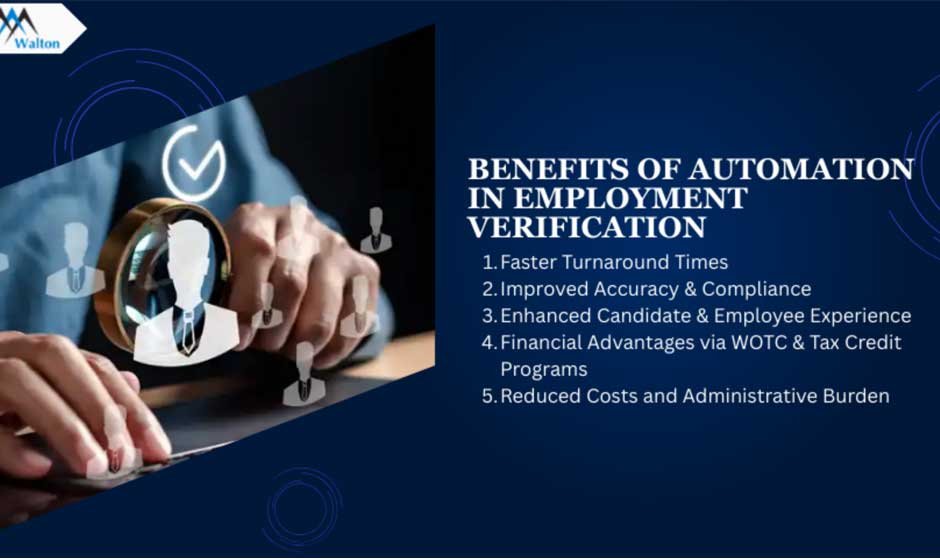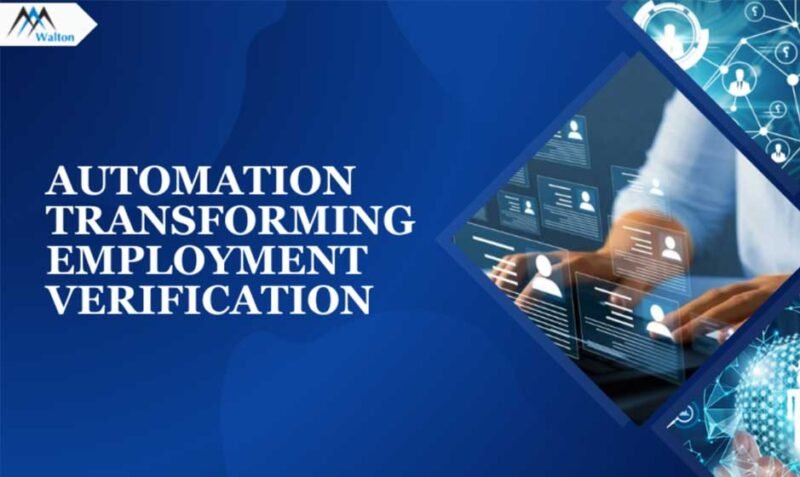Introduction
Employment verification has long been a cornerstone of workforce management, hiring, and compliance. Employers, financial institutions, and government agencies rely on Verification of Employment to confirm details such as job titles, dates of employment, and income levels. Traditionally, this has been a slow, error-prone, and resource-intensive process. Today, HR Automation and background verification services are transforming the landscape.
Automation in Verification of Employment is streamlining how organizations confirm employment and income details, delivering faster results and reducing administrative burdens. By embedding digital tools and AI into background verification services and employment verification, businesses not only improve accuracy but also enhance compliance with programs such as the Work Opportunity Tax Credit (WOTC) and other Tax Credit incentives.
The shift toward HR Automation in background verification services is not just a technological upgrade; it is a strategic move. Faster Verification Of Employment supports efficient hiring, improves employee experience, strengthens eligibility checks for WOTC and other Tax Credit programs, and reduces risks associated with manual verification errors. Industry experts highlight that automation in the Verification of Employment is becoming a necessity rather than an option.
The Traditional Employment Verification Process
Traditional Verification Of Employment methods often depend on manual work, paper forms, phone calls, and antiquated record-keeping systems. Employment verification mistakes and ways to prevent them. Background verification services relying on these processes confront many bottlenecks and inefficiencies.
Key Steps in Traditional VOE & Where Challenges Arise
- Request submission and data collection
A verifier (employer, lender, or agency) submits a request to HR or the prior employer for proof of employment, often asking for job title, dates, salary, and sometimes payroll records or tax forms. Forms may be filled out manually, or suitable documents may be requested.
- HR / previous employer response delays
HR teams or past employers may be slow to respond due to limited staff, heavy workloads, or inadequate systems. Paper or email follow-ups, phone calls, and incomplete information are common. Background verification services see delays when names are misspelled, company names are out of date, or prior employer records are archived poorly.
- Manual verification & cross-checking
HR or verification agencies check documents manually, including payroll stubs, employment contracts, bank statements, and tax or financial records. This involves human error risk, duplicate effort, and inconsistency in formatting.
- Compliance and paperwork hurdles
Ensuring that requests align with legal and regulatory requirements (such as consent, data privacy rules, FCRA in the U.S., or other jurisdictional laws) usually requires multiple checks. Paperwork may not need notarization or verification of authenticity, adding further time.
- Turnaround time & candidate friction
The entire process can take several days to weeks, depending on volume, geography, and responsiveness. Background verification services report delays often in the 3-7 business day range for standard VOE, longer for complex or international employment. Applicants, lenders, or agencies experience uncertainty, increased administrative burden, and sometimes drop-offs.
Challenges & Costs of the Traditional Process
- Time delaysreduce operational efficiency and slow hiring or financial decision-making. For example, manual employment verifications typically exceed five days for turnaround, inflating labor costs and reducing satisfaction.
- Higher direct and hidden costs:time spent by HR staff chasing missing documents or contacting previous employers, payroll or administrative overhead, risk of losing applicants or deals. Background verification services using traditional VOE reports lost revenue due to slow responses.
- Errors and inconsistenciesare common in manual data handling. Employment verification reports point out that names, dates, and salaries can be mis-entered or mismatched, leading to rework or disputes.
- Compliance riskemerges when forms lack proper consent, information is stored or transmitted incorrectly, or regulatory requirements differ by jurisdiction. Traditional VOE often leaves gaps in audit trails or documentation.
Evidence & Statistics from Background Verification Services
- Manual employment verification often delays hiring by 3 to 5 business days on average; longer when the previous employer is in a different region or HR records are decentralized.
- Labor cost for manual verification can be considerably higher when factoring in HR staff time, overhead, and opportunity cost. Argyle reports that while manual verification may seem cheaper upfront, it actually elevates costs when volumes are high and delays occur.
- Incomplete or incorrect information in requests (such as names, company details, and dates) significantly contributes to verification delays. PSI Background Check notes that problems with forms or wrong information cause major delays in VOE.
The Rise of Automation in Employment Verification
Automation in the Verification Of Employment has shifted from concept to operational reality. Background verification services now increasingly adopt HR automation, leveraging APIs, AI, integration with HRIS/payroll platforms, and digital consent systems. Digital I-9 and employment verification provide essential guidelines that employers need to follow. This rise enhances speed, reliability, and compliance in how employment history, income, and job status are verified.
Key Innovations Driving Automation
- API-led Integration with HRIS / Payroll / HCM Platforms
Modern background verification services connect directly to HRIS or payroll systems. This enables Verification of Employment requests to pull job title, income, and dates of employment in real time without manual input. Such integrations powered by Hr Automation reduce lag, reduce errors, and support Tax Credit / WOTC processing by providing accurate historical employment data immediately. For example, Truework Guardian automates income and employment verification for millions of employees by connecting payroll systems and reducing manual handling.
- AI / Machine Learning-based Document Validation & Risk Scoring
Automated VOE systems apply AI to validate submitted documents (e.g., pay stubs, contracts), to flag anomalies (salary spikes, date mismatches), and to apply risk scoring to determine which Verifications Of Employment can be auto-approved vs those needing human review. Background verification services with these capabilities enhance compliance, accuracy, and reduce fraud risk.
- Remote Verification and Digital Identity Tools
The demand for remote work, distributed teams, and hybrid employment has made remote Verification of Employment critical. Tools using digital identity verification, secure document upload, remote signature, or electronic attestations are becoming part of Hr Automation and background verification services. This allows remote applicants/employees to provide proofs more securely, with less delay. For example, updates in Form I-9 rules and remote verification options illustrate a regulatory push for automation in eligibility verification.
- Real-Time or Near-Real-Time VOE and Continuous Data Feeds
Background verification services now use continual data feeds or periodic syncs with payroll/HCM systems so that employment status, income, and job title remain up-to-date. Verification of Employment becomes more reliable, especially for Tax Credit and WOTC, where eligibility may depend on recent employment history. API systems enable automatic updates. For example, Vault Verify provides real-time API connections for employment and income verification, along with Tax Credit support.
- Consent Management, Audit Trails, and Compliance Automation
With automation, consent from employees/applicants is managed digitally; every request in Verification of Employment is logged; audit trails support compliance. For background verification services, these features reduce legal risk. Regulation trends demand transparent logs, secure storage, and identity verification.
Benefits Specific to WOTC, Tax Credit & Background Verification Services
- WOTC and other Tax Credit programs require evidence of eligibility, often based on past employment, income, and/or demographic data. Automation reduces delays in obtaining this documentation via Verification of Employment.
- Background verification services with Hr Automation ensure that records for Tax Credit-eligible hires are accurate, accessible, and retrievable, improving audit readiness.
- The speed of automated Verification of Employment allows earlier claims for Tax Credit/WOTC, reducing opportunity cost and improving cash flow for organizations.
Benefits of Automation in Employment Verification
Automation in Verification of Employment is no longer just about reducing paperwork; it has become a strategic tool in workforce management, compliance, and finance. Background verification services powered by Hr Automation help organizations gain accuracy, improve efficiency, and unlock financial opportunities such as WOTC and other Tax Credit incentives.

1. Faster Turnaround Times
Traditional processes often delay Verification of Employment for several days or even weeks. Automation compresses that timeline to hours or even minutes. Studies indicate that automated background verification services cut average VOE processing time by more than 70%.
Speed is especially critical for lenders evaluating credit, landlords checking tenants, or HR teams onboarding employees. Delays in Verification of Employment can result in lost candidates or stalled business deals, but Hr Automation resolves this friction.
2. Improved Accuracy & Compliance
Manual verification methods are prone to human error. Names, salaries, or employment dates often get entered incorrectly, leading to disputes or re-work. Automation reduces these risks by pulling directly from payroll systems or HR databases, ensuring consistency.
Automated Verification of Employment tools can validate data instantly, decreasing error rates and improving compliance with legal frameworks such as the Fair Credit Reporting Act (FCRA).
Automation also supports audit trails. Every Verification of Employment request is digitally logged, improving accountability for background verification services while meeting regulatory requirements.
3. Enhanced Candidate & Employee Experience
Long delays in employment verification frustrate applicants. Automated background verification services provide quicker responses, creating a smoother hiring process. Candidates feel respected when Verification of Employment happens quickly, and employers benefit from faster onboarding.
4. Financial Advantages via WOTC & Tax Credit Programs
Automation plays a major role in capturing WOTC and other Tax Credit opportunities. Background verification services that integrate automated Verification Of Employment can quickly determine whether a new hire qualifies for WOTC or similar Tax Credit incentives.
Accurate, timely data enables employers to claim these credits without delay. The U.S. Department of Labor notes that employers can save thousands per eligible hire through the WOTC program.
HR Automation ensures that eligibility records are stored, retrieved, and submitted on time, reducing the risk of missing valuable Tax Credit savings.
5. Reduced Costs and Administrative Burden
Manual Verification of Employment requires significant staff time to manage calls, forms, and follow-ups. Automation reduces this workload, cutting down administrative costs. Automating background verification services not only reduces HR workload but also minimizes hidden costs like applicant drop-offs and re-work.
Future Trends in Automated Employment Verification
The trajectory of Hr Automation in Verification of Employment indicates that automation will soon become the default rather than the exception. Background verification services are evolving rapidly, with several future trends shaping the landscape.
1. Integration with AI & Predictive Analytics
AI is being deployed not just to validate documents but also to predict risk factors. Predictive analytics in background verification services will help organizations detect fraudulent employment claims, salary misstatements, or identity theft before approvals.
2. Expansion of Blockchain for Data Security
Blockchain is expected to strengthen Verification of Employment by offering tamper-proof digital records. Employees may eventually carry a secure blockchain-based “digital wallet” containing verified employment and income history.
3. Continuous Employment Verification
Instead of single-time verifications, background verification services will shift toward continuous verification models. Payroll and HR systems will sync regularly, keeping employment and income data always updated. This approach benefits employers applying for WOTC or other Tax Credit programs, since real-time data makes compliance easier.
4. Globalization & Remote Workforce Checks
With the rise of global hiring, Verification of Employment will increasingly require cross-border capabilities. Hr Automation will integrate with international databases, supporting compliance with local labor laws and tax regulations.
5. Deeper Links to Financial Services & Tax Credit Programs
Banks, mortgage lenders, and government agencies will rely more on automated Verification of Employment to speed up financial approvals. Background verification services tied directly into tax systems will make claiming WOTC and other Tax Credit programs seamless.
Conclusion
Automation is revolutionizing Verification of Employment, transforming it from a manual, error-prone task into a streamlined, technology-driven process. Background verification services using Hr Automation provide faster results, higher accuracy, and stronger compliance, all of which are vital in today’s fast-paced business landscape.
The benefits go beyond efficiency. Automated Verification of Employment empowers organizations to claim WOTC and other Tax Credit programs quickly, boosting financial outcomes. It also strengthens compliance frameworks, reduces fraud risk, and improves candidate experiences by shortening hiring timelines. For organizations seeking tailored solutions in this area, contact Walton Management Services to learn how advanced HR Automation can simplify Verification of Employment and enhance background verification services.
Future trends such as AI integration, blockchain credentials, continuous employment verification, and global compliance tools will only accelerate this shift. Background verification services that adapt quickly to Hr Automation will be better positioned to meet evolving workforce demands and regulatory requirements.
Organizations embracing automation in Verification of Employment gain a decisive advantage in HR operations, compliance, and financial management. As technology continues to mature, automation is not just transforming how background verification services operate; it is redefining the future of employment verification itself.









